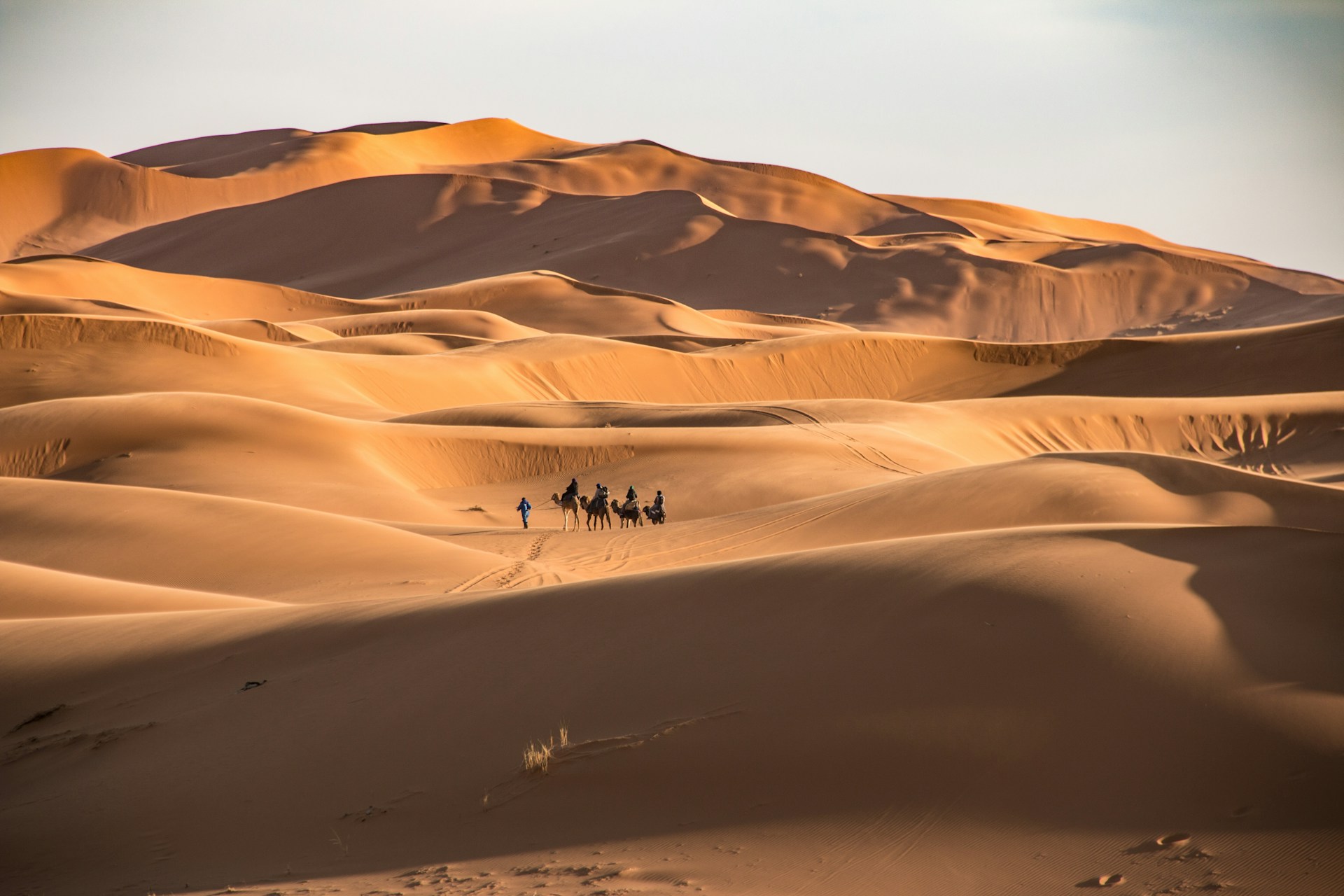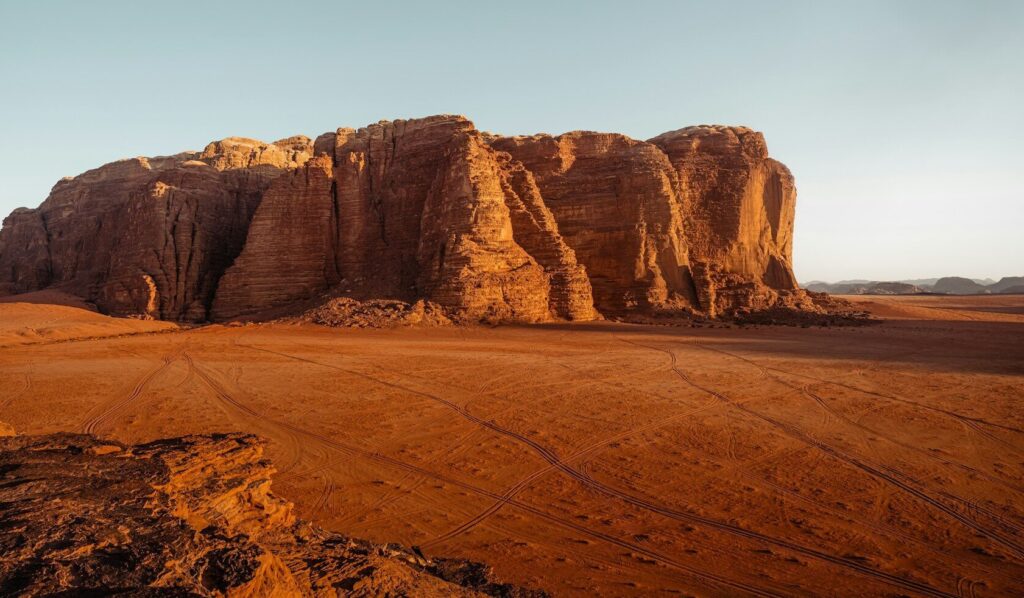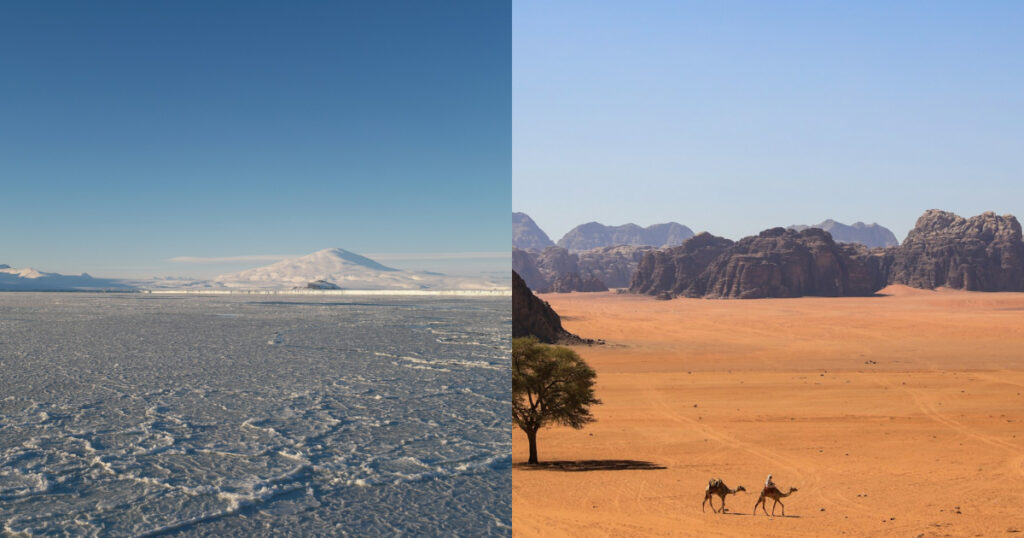Deserts conjure up images of vast, sandy landscapes under a scorching sun. But these arid regions are far more diverse than that! From icy polar deserts to coastal fog deserts, they cover a surprising amount of the Earth’s surface (about 33%!) and boast unique ecosystems.
What is a desert?
A desert is a region that receives very little rain, typically less than 25 centimetres (10 inches) annually. This lack of precipitation creates a harsh environment with sparse vegetation and specific adaptations for the plants and animals that call it home.
There are five main types of deserts:
- Hot and dry deserts: These are the classic deserts you might picture, with sand dunes and scorching temperatures. The Sahara Desert is a prime example.
- Cold deserts: These deserts experience freezing temperatures and very little rain or snowfall. The Gobi Desert in Asia is a cold desert.
- Coastal deserts: These deserts occur along coastlines where cool ocean currents suppress precipitation. The Atacama Desert in South America is a coastal desert.
- Semiarid deserts: These regions receive slightly more rain than typical deserts, but not enough to support lush plant growth. Parts of the Great Plains in North America are considered semiarid.
- Polar deserts: These frigid deserts are found at the Earth’s poles and receive very little snowfall. Antarctica is the world’s largest polar desert.
How many deserts are there?
Deserts cover about one-third of the Earth’s landmass, so there are quite a few! An exact number can vary depending on what definition you use, however it is commonly agreed that there are 33 deserts on earth. Here’s a general breakdown by continent:
- Africa: The Sahara, the continent’s crown jewel, is the world’s largest hot desert. Africa also boasts the Kalahari Desert and the Namib Desert.
- Asia: Home to the vast Gobi Desert and the Arabian Peninsula’s Arabian Desert, Asia has a significant portion of the world’s desert landscapes.
- Australia: The Australian continent, also known as the Outback, is largely desert. The Great Victoria Desert and the Gibson Desert are two of the major ones.
- North America: Death Valley in California might be the most famous, but North America also has the Great Basin Desert and the Chihuahuan Desert.
- South America: The Atacama Desert, known for its coastal fog and extreme aridity, is in South America. The Patagonian Desert is another major desert region here.
- Antarctica: The largest desert on Earth is Antarctica. It may be very cold, but it is considered a desert because it receives very little precipitation.
Europe is said to be the only continent without a desert, but again this is debated due to varying definitions. There are some ‘semi-deserts’ such as the Tabernas Desert in Spain.

The Largest Deserts in the World
Here’s a top 10 list of the world’s biggest deserts, ranked by size:
- Antarctic Desert
- Arctic Desert
- Sahara Desert, Africa
- Great Australian
- Arabian Desert, Middle East
- Gobi Desert, Asia
- Kalahari Desert, Southern Africa
- Patagonian Desert, Argentina
- Syrian Desert, Middle East
- Great Basin, USA
The Hottest Desert in the World
The title of hottest desert goes to the Lut Desert in Iran. In 2005, temperatures reached a scorching 70.7°C (159.3°F)! Death Valley in California is often a contender for hottest desert, but it doesn’t quite reach the same scorching highs as Lut.
The Coldest Desert in the World
While Antarctica might not be the first place that comes to mind when you think of deserts, it holds the title of the world’s coldest and largest polar desert. This vast, icy expanse receives very little snowfall, technically defying the typical definition of precipitation. However, with average annual temperatures hovering around a bone-chilling -20°C (-4°F), and the record-breaking -89.2°C (-128.6°F) recorded at Vostok Station in 1983, Antarctica is undoubtedly a contender for the most extreme desert environment. Despite the harsh conditions, life persists here, with fascinating microscopic organisms adapted to the frigid desert.

The Most Beautiful Desert in the World
Alright, so we freely admit some bias here at See Wadi Rum, but we truly believe the desert landscape we call home is unlike any other on Earth. Wadi Rum is a stunning spectacle of sandstone cliffs, towering rock formations, and vast stretches of red sand. Located in Jordan in the Middle East, the dramatic scenery has captivated travellers for millennia, and it’s easy to see why.
Imagine yourself cruising through the desert on a thrilling 4×4 jeep tour, feeling the wind whip through your hair as you explore hidden canyons and ancient inscriptions. Or, perhaps a sunrise camel ride is more your pace, allowing you to soak in the panoramic views at a slower, more traditional pace.
But the adventure doesn’t have to end when the sun sets. Picture yourself nestled in a comfortable camp beneath a sky ablaze with stars, a million miles away from light pollution. See Wadi Rum offers the chance to experience the magic of Wadi Rum not just by day, but also under the vast desert night sky.
So, if you’re looking for an unforgettable desert adventure, Wadi Rum should be at the top of your list. Let See Wadi Rum be your guide, and we’ll show you the beauty and wonder of this extraordinary place.
